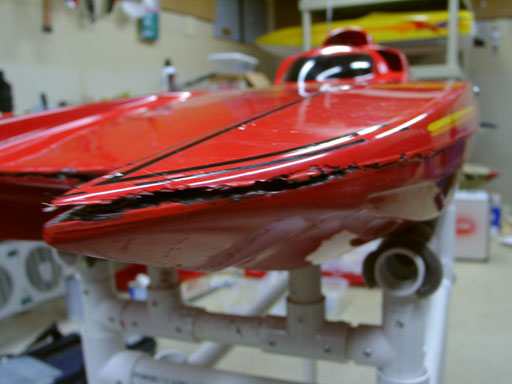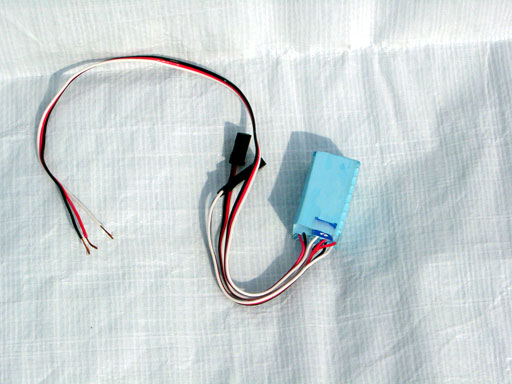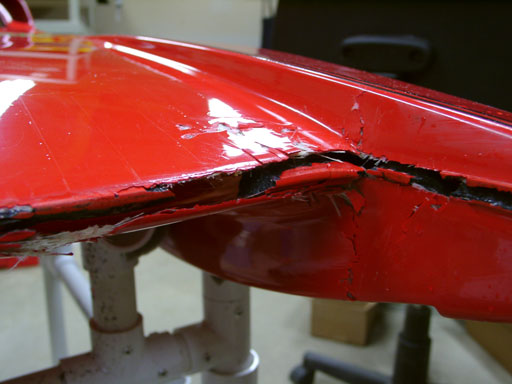Misc. Article ...by Rudy Hilado

Read about the advantages of using a failsafe device in you R/C Boat...
 What is a
boat fail-safe and why is it so important? A boat fail-safe is a device that is
designed to prevent your boat from going out of control in the event that you
lose radio contact and control.
What is a
boat fail-safe and why is it so important? A boat fail-safe is a device that is
designed to prevent your boat from going out of control in the event that you
lose radio contact and control.
Murphy's Law will often play a role in model boating--"If anything can go wrong, it will". A fail-safe device is relatively inexpensive insurance when something goes wrong.
There are several types and variations of fail-safe devices that can be used on your boat. The most common fail-safe protects your boat from radio glitches and interference. This type of fail-safe is installed between the radio receiver and the throttle and sometimes the steering servo. When the device senses radio interference or loss of the radio signal, it will automatically actuate the servo to close the throttle, which can stop the engine or bring it to an idle (some will also turn the rudder). Most high-end radios have this feature built into the receiver. If your radio doesn't have this feature, you can purchase a 3rd party radio fail-safe typically between $30-$60.
Although radio interference is probably the most common cause of "glitches", there are other scenarios that can jeopardize the control of your model boat. If power was lost to the receiver (due to batteries or a connector jarring loose), the radio fail-safe would offer no protection. Without power, the fail-safe doesn't function and the servos will remain essentially frozen in place. The most economical solution for this scenario is to use a throttle return spring. This involves mounting a strong spring in a fashion that would force the carburetor closed if the servo lost power. The down side to a throttle return spring include the difficulty of locating mounting areas for the spring, and the fact that the throttle servo will always be fighting against it, increasing the drain on the receiver battery.
There is also another simple solution to this problem. Since we run motors that use spark plugs, there the motor can be easily stopped if the spark coil is grounded. By employing a small electrical relay, the spark plug can be grounded if power is lost to the relay, thus stopping the motor. A slight variation to this problem is when the battery pack is getting low and it is unable to actuate the throttle servo properly. Most of the radio fail safes can sense a low battery condition and stop the boat before the servo stops functioning.
Another problem that can cause you to lose control of your boat is mechanical failure. The linkage between the servo and throttle can be jammed or disconnected. And even though the radio is working fine and receiving power, you'll be unable to control the boat. This is more difficult to protect against since there are many points that can suffer mechanical failure.
A variety of radio fail safes are available, but few are designed specifically for use in model boats (unless they are integrated into the receiver), where water can be an issue.
 There is one fail-safe, produced by
Shark-Racing, that is waterproof and it can handle all the failure scenarios
described above. Carlos Andrade and his Shark -Racing team are on their 3rd
variation of their fail-safe. This device integrates a radio fail-safe, a motor
kill switch, a low battery warning indicator and the circuitry to detect a
disconnected throttle servo. You can find out more about this wonderful device
on the Shark-Racing web site (Carlos' site is unfortunately now down
indefinately.)
There is one fail-safe, produced by
Shark-Racing, that is waterproof and it can handle all the failure scenarios
described above. Carlos Andrade and his Shark -Racing team are on their 3rd
variation of their fail-safe. This device integrates a radio fail-safe, a motor
kill switch, a low battery warning indicator and the circuitry to detect a
disconnected throttle servo. You can find out more about this wonderful device
on the Shark-Racing web site (Carlos' site is unfortunately now down
indefinately.)
I have a couple of these great fail-safe devices, but like seat belts and motorcycle helmets, they don't work unless you use them...
I recently built a new boat, and in my excitement and haste to rush out to the pond and give it a spin, I neglected to install my fail-safe device. And of course, Murphy hit me hard. During one of the runs, I was doing a high speed turn when my battery became disconnected from the receiver. I lost all control of the boat and it ran full speed into the bank and up into a small tree. The consequences of the crash are pretty evident--the whole front end was smashed in! This could have been easily prevented if I took the time to install my fail-safe device. When the power was lost, the boat would have stopped dead in the water.
In
an instant this crash turned an expensive and "pretty" boat into an expensive
"ugly" boat. Although I was
upset at my own carelessness, I learned a valuable lesson. A small investment
into a fail-safe can provide a priceless amount of insurance! A fail-safe can
protect your boat, your peace of mind, and add to the safety of those around the
lake. I can imagine a time in the future when fail-safe devices may be required
equipment. In the mean time, it just makes common sense to use one.
was
upset at my own carelessness, I learned a valuable lesson. A small investment
into a fail-safe can provide a priceless amount of insurance! A fail-safe can
protect your boat, your peace of mind, and add to the safety of those around the
lake. I can imagine a time in the future when fail-safe devices may be required
equipment. In the mean time, it just makes common sense to use one.


